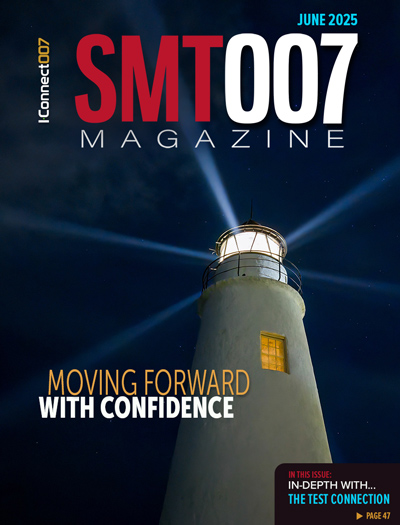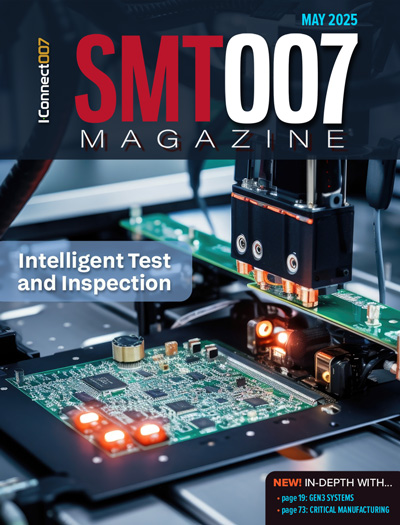-

-
News
News Highlights
- Books
Featured Books
- smt007 Magazine
Latest Issues
Current Issue
What's Your Sweet Spot?
Are you in a niche that’s growing or shrinking? Is it time to reassess and refocus? We spotlight companies thriving by redefining or reinforcing their niche. What are their insights?

Moving Forward With Confidence
In this issue, we focus on sales and quoting, workforce training, new IPC leadership in the U.S. and Canada, the effects of tariffs, CFX standards, and much more—all designed to provide perspective as you move through the cloud bank of today's shifting economic market.

Intelligent Test and Inspection
Are you ready to explore the cutting-edge advancements shaping the electronics manufacturing industry? The May 2025 issue of SMT007 Magazine is packed with insights, innovations, and expert perspectives that you won’t want to miss.
- Articles
- Columns
- Links
- Media kit
||| MENU - smt007 Magazine
Tales from a Trailblazer: An Interview with Christine Davis
January 5, 2021 | Steve Williams, The Right Approach Consulting LLCEstimated reading time: 6 minutes
Steve Williams, president of The Right Approach Consulting and I-Connect007 columnist, recorded a series of interviews with new I-Connect007 columnist Christine Davis, president and founder of contract manufacturer CAMtek, who recently joined Zentech Bloomington. As a female business owner in a male-dominated industry, Christine has a unique perspective on what it takes to thrive in the electronics industry, and shares some of her stories and lessons learned along the journey.
Steve Williams: Christine, your history of the evolution of CAMtek is full of fascinating stories. Why don’t we begin with hearing why you decided to start a contract manufacturing business?
Christine Davis: I had worked at two CMs prior to founding CAMtek, and I had grown the first business significantly, which led to an opportunity to do the same at a second CM with the promise of an equity position. I upheld my end of the bargain and improved performance, financials, and growth, but the management reneged on the equity promise, so I left.
Steve: Having been in a similar position before starting my business, I know how scary that can be. What led to your vision of CAMtek instead of finding a position with another CM?
Christine: Well, owning my own business had never been an aspiration of mine, but as I considered what to do now that I was unemployed, I started thinking about forming my own CM business. I guess I was tired of putting my heart and soul into someone else’s business, so after much thought and discussion, I decided, “I can do this!” I had a lot of support from my husband, who sold his motorcycle dealership so we could pool our money. We borrowed the rest of the money we needed from family and the bank.
Steve: How did the bank treat you?
Christine: Banks have always treated me well, perhaps for my “woman owned business” status and background as a CPA, but they have always supported my plans and needs.
Steve: After you decided to start your company, I’m sure you sought out counsel from a number of people. What was the best advice you received?
Christine: Sure, that’s easy! I just remember going to my father's boss at the time. My father worked for BorgWarner, which made car air compressors. His boss was a very nice man. He was also very wealthy, and we were initially talking about him possibly investing in my company. I showed him my business plan and he really liked it, but he told me he wasn't going to invest in me at this point. He said I needed to rethink it because my plan was going to cost me twice as much and take twice as long to achieve what I wanted. I thought he was nuts, but I listened to him and I really looked at my numbers—I looked at everything, actually—and decided to move forward with my plan. He was right, though; it did cost me a lot more and take a lot longer than I originally thought.
Steve: You mentioned he also critiqued your grammar?
Christine: He did. He criticized my grammar, which was very embarrassing. I grew up in an age where grammar was thrown out of schoolbooks. In fact, there are a lot of people in my hometown that have this same grammar. Once it was pointed out to me, I could even see it on the TV news. I sat down with my mother, who has excellent grammar, and told her I needed help to correct a few things. She knew she could help, and instantly listed off five words that she knew I was pronouncing or using improperly. It was things like, “cuz” instead of “because,” or saying “me and you.” Now I know to say “you and I” or “Greg and me,” not “me and Greg.” I learned how to flip things around. To this day, I still feel intimidated about my grammar, so I'm very careful.
Steve: That's a lifelong lesson. It was a small-town thing and that's how everybody talked, right?
Christine: Yes, but you know, we'll say “pop” and they'll say “soda pop” or something, that whole thing. But when it came to stepping into a new arena, this gentleman was very kind, but he said my grammar was driving him up the wall.
Steve: That's funny.
Christine: He could see that I was smart enough, but he told me my grammar needed to reflect that. Now, I’m much more careful. I double-check all my emails, and I make sure things are written properly and to the best of my ability.
Steve: I can relate to that. My family is from southern Illinois, and we learned when we moved up here to Wisconsin about how words were used differently, like using “bubbler” vs. “water fountain.”
Christine: Right, but mine was more about sloppy grammar. I'm still learning, and my mom is still correcting me. It irritates me to no end, but I listen to her. She's my inspiration. She's as healthy as anyone could be at 90 years old, still driving around town. Everybody knows her as grandma.
Steve: Good for her!
Christine: She comes in, uses the shredder or the copy machine, and everybody welcomes her and gives her hugs.
Steve: That's an interesting story. It sounds like his advice was fairly accurate about your business plan, though. Maybe it didn’t take quite as long, but it did cost you more.
Christine: It took more investment than I had planned. With the timing, we got into our building pretty quickly. And I started all the marketing even before I had a building or equipment.
Steve: What were you selling?
Christine: I was selling my concept. I went to diversity trade shows with a few pictures and an idea. There, I learned how to become a woman-owned business. I learned that I had to be in business for two years before I could get certified. But I was also talking to companies like Northrup Grumman and Raytheon.
Steve: So, you had a concept and a business plan. What was the next step?
Christine: Once I secured the financing, I decided to attend IPC APEX EXPO to buy equipment. I believe it was in 2000 and it was the first show after transitioning from the old NEPCON. Since I had no physical company yet, I simply circulated literature based on my concepts. I purchased my first SMT assembly line on the show floor, and on the way home, I thought, “I need to find a building before the equipment comes in!”
Steve: Let’s talk about that first building and setting up manufacturing.
Christine: Finding our first building was not as difficult as I anticipated; it was only 10,000 square feet but it was plenty big enough. In fact, I still remember rollerblading in the back 40 after we were operational. I was lucky to have had one process engineer from my previous job who become a CAMtek employee and helped me set up our first SMT line. There was a local competitor with that same line, but we had a good relationship, so I went over to see their line and compare notes. I noticed that the sequence of their line was set up differently than mine. The owner mentioned all the process problems they were having on the line, and after much discussion we determined that we had it right. His company ended up duplicating our setup and his problems went away.
Steve: So, you backed your way into helping a competitor while validating that you really do know what you are doing. That must have felt good.
Christine: It did, and while I have never lacked confidence, this was my first practical “business owner issue” that confirmed that I really can do this.
Steve: Christine, thank you for sharing your thoughts and stories. I believe a lot can be learned from your experiences and success in our industry and I look forward to talking again soon.
Christine: Thank you Steve. I do hope that my experiences can in some way help other women business owners or women who would like to be.
Christine Davis’s column appears online twice monthly. Steve Williams’s column appears monthly in PCB007 Magazine.
Suggested Items
IPC Hall of Fame Spotlight Series: Highlighting Lionel Fullwood
07/15/2025 | Dan Feinberg, I-Connect007Many IPC members who have contributed significantly to IPC and our industry have been awarded the IPC Raymond E. Pritchard Hall of Fame (HOF) Award. Though many early HOF members have passed away and are unknown to today’s IPC membership, their contributions still resonate. This special series on IPC Hall of Fame members provides a reminder of who was honored and why. As a bonus, for those who are still around, we get to find out what these talented individuals are up to today.
TRI Unveils New Platform for Diverse Board Sizes Search Submit
07/14/2025 | TRITest Research, Inc. (TRI), the leading test and inspection systems provider for the electronics manufacturing industry, proudly introduces a new size configuration for SPI and AOI Models.
Seeing a Future in Mexico
07/09/2025 | Michelle Te, I-Connect007The Global Electronics Association (formerly known as IPC) has been instrumental in fostering a partnership with Guanajuato, a state north of Mexico City with 12 industrial clusters and close to 150 companies involved in electronics. This past spring, Alejandro Hernández, the undersecretary for investment promotion in Guanajuato, attended IPC APEX EXPO 2025 at the invitation of IPC Mexico Director Lorena Villanueva, where he met with several companies to discuss the opportunities available in Mexico. He is inviting electronics-related companies seeking long-term investment in a centrally located area with access to highways, railways, and ports.
The Global Electronics Association Releases IPC-8911: First-Ever Conductive Yarn Standard for E-Textile Application
07/02/2025 | Global Electronics AssociationThe Global Electronics Association announces the release of IPC-8911, Requirements for Conductive Yarns for E-Textiles Applications. This first-of-its-kind global standard establishes a clear framework for classifying, designating, and qualifying conductive yarns—helping to address longstanding challenges in supply chain communication, product testing, and material selection within the growing e-textiles industry.
IPC-CFX, 2.0: How to Use the QPL Effectively
07/02/2025 | Chris Jorgensen, Global Electronics AssociationIn part one of this series, we discussed the new features in CFX Version 2.0 and their implications for improved inter-machine communication. But what about bringing this new functionality to the shop floor? The IPC-CFX-2591 QPL is a powerful technical resource for manufacturers seeking CFX-enabled equipment. The Qualified Product List (QPL) helps streamline equipment selection by listing models verified for CFX compliance through a robust third-party virtual qualification process.


